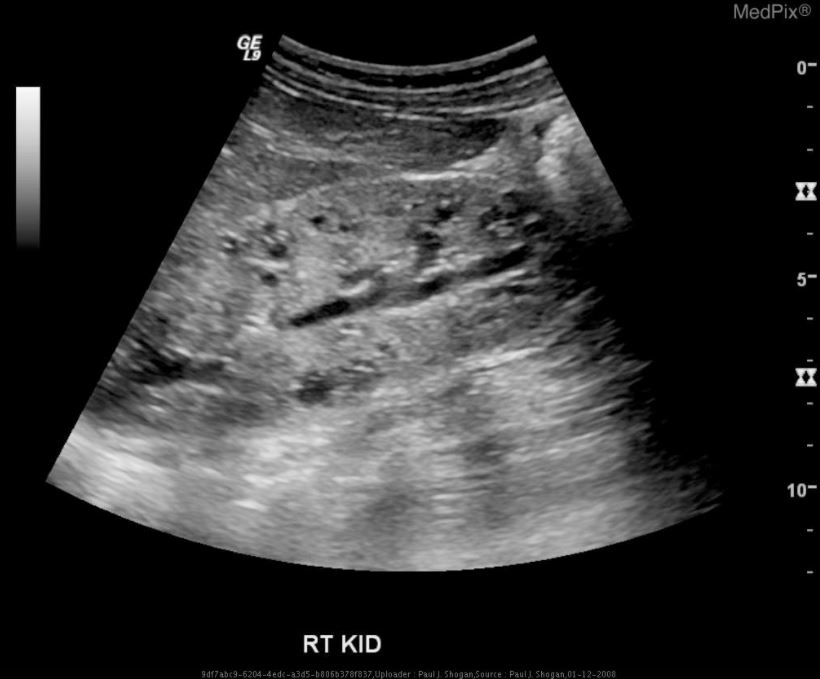Playlist
Show Playlist
Hide Playlist
Autosomal Recessive Disease (Juvenile)
-
Slides RenalCystrePathology IntegratedRenalPathology.pdf
-
Download Lecture Overview
00:00 Juvenile polycystic kidney disease, we’ll go ahead and call this juvenile for learning purposes and most common presentation. 00:08 However, the technical name is autosomal recessive polycystic kidney disease. 00:14 So what about this one? Obviously, there is an inheritance pattern, isn’t there? In renal dysplasia, not the case. 00:21 Bilateral cystic diseases, cysts in the cortex and medulla. 00:26 I want you to pay attention to the location of the cyst. 00:29 Both kidneys, cortex, and medulla. 00:33 Now as a rule of thumb, whenever we talk about these polycystic kidney disease conditions, whenever you find a cyst in the kidney, it’s very likely that you might find cysts in the liver as well, is that clear? Now, we go one step further. 00:50 How old is your patient here? A child, a child that’s having cysts in the kidney. 00:58 Okay, now, there are cysts there also developing in a child’s liver, uh-oh, why? All of a sudden, you’re damaging the liver. 01:09 As soon as you bring in any type of injury to an organ except the brain shall we say, you’re going to recruit fibroblast that are then going to deposit, what? Collagen. 01:20 Why did I exclude the brain? The brain doesn’t have fibroblast but most of the organs especially the liver has fibrosis taking place. 01:32 Can you imagine this child in which all of a sudden fibrosis of the liver is taking place? A child. The child’s liver hasn’t even had a chance to develop yet. 01:41 Uh-oh, give me the sequelae. It’s called portal hypertension. 01:46 What is this condition called here with the autosomal recessive polycystic kidney disease? Congenital, hepatic, hepatic fibrosis. 01:56 So what organ am I referring to? Touch yourself right here, right upper lobe, liver, that’s being damaged resulting in portal hypertension. 02:04 You may use the pneumonic head, butt, caput, I think it’s kind of cute. 02:08 Head, butt, caput, all portal hypertension. 02:11 Now, by head, work with me here, esophageal varices. 02:15 The most important one, isn’t it? That’s what we’ll focus upon. 02:19 Why? Imagine if you had esophageal varices taking place and you have swelling of your blood vessels, of a child’s blood vessels up by the esophagus, and then, what happens? They might have rupture. 02:34 Rupture may then take place resulting in choking and suffocation effects of the child resulting in rupture of the esophageal varices. 02:44 What do you know about esophageal varices? You need to get in there and treat the patient ASAP. 02:49 Your child might die, you don’t want that. 02:52 Portal hypertension not to your head, butt, caput, what is that? Your butt would be hemorrhoids and then caput would be caput medusae, is that clear? Congenital hepatic fibrosis, much more so with autosomal recessive type because it occurs in children. 03:07 Usually, you don’t find such conditions with autosomal dominant and we’ll discuss as to why. 03:13 Enlarged kidneys at birth, most serious types are incompatible with life. 03:18 Once again, you know about if the kidneys are not properly developed as an infant, as a fetus. 03:25 What is Potter sequence? Uh-oh, oligohydramnios. 03:30 What does that mean? Very little amniotic fluid in the placenta. 03:33 Now, this fetus’ world is caving in on him or her, the fetus. 03:38 So then what happens? Potter sequence. 03:40 What does that mean? Flattened face, flattened nose, recessed chin, low-set ears, most importantly, the lungs are not developing properly, incompatible with life. 03:49 Maternal oligohydramnios, decreased amniotic fluid. 03:54 Remember, our discussion way back when we began nephrology began by looking at amniotic fluid, I told you for pathologic purposes, you wanna keep the circuit of amniotic fluid quite simple. 04:06 A fetus in the placenta is going to “swallow” the amniotic fluid and urinate the amniotic fluid, continuous cycling. 04:16 Think of it because this is then going to give you the clinical picture. 04:20 If the kidneys are damaged, then you don’t “urinate” as much amniotic fluid and so therefore, what kind of clinical situation or picture are you gonna have on ultrasound? Oligohydramnios. Good. 04:34 Newborns have potter’s facies. 04:36 What we just talked about earlier where the fetal world is caving in upon the fetus resulting in flattened nose, parrot beak nose, low-set ears, lung hypoplasia is the big issue. 04:50 Incompatibility with life, be careful, autosomal recessive.
About the Lecture
The lecture Autosomal Recessive Disease (Juvenile) by Carlo Raj, MD is from the course Cystic Diseases (Renal Cystic Pathology).
Included Quiz Questions
Which of the following is a typical physical appearance of a baby due to oligohydramnios?
- Potter sequence
- DiGeorge syndrome
- Alagille syndrome
- VACTERAL association
- Smith–Lemli–Opitz syndrome
Which of the following statements about autosomal recessive polycystic kidney disease is INCORRECT?
- It is always asymptomatic.
- Cysts are usually located in both kidneys.
- It is associated with hepatic fibrosis.
- It can result in oligohydramnios.
- Cysts typically develop in the cortex and medulla of the kidneys.
Customer reviews
5,0 of 5 stars
| 5 Stars |
|
5 |
| 4 Stars |
|
0 |
| 3 Stars |
|
0 |
| 2 Stars |
|
0 |
| 1 Star |
|
0 |




